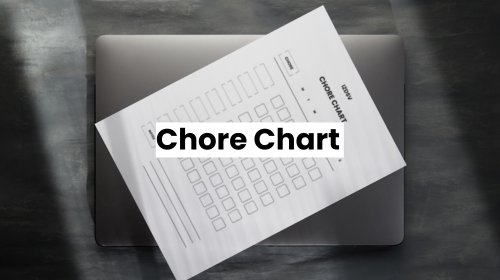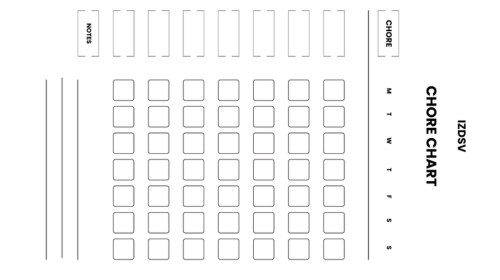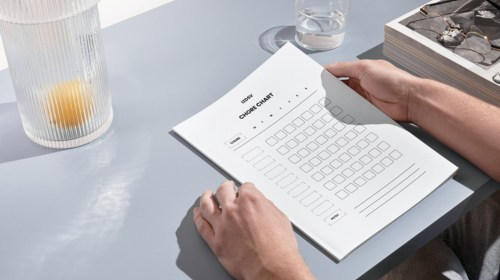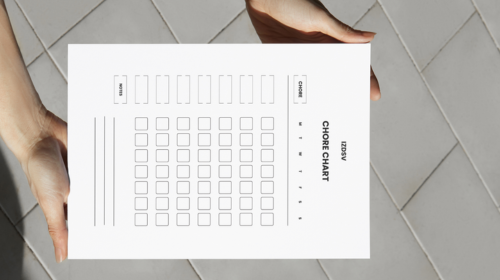Magnetic Chore Chart: A Fun Way to Track Daily Chores at Home
What is a Magnetic Chore Chart?
A magnetic chore chart is a visual organizational tool that uses magnets to track household tasks and responsibilities. It typically consists of a metal board or surface with magnetic pieces that can be moved to indicate completed chores or assignments.
- Typically made with a metallic backing (like a whiteboard with metal underneath)
- Features magnetic pieces representing different chores or responsibilities
- Can be customized for individual family members
- Usually displays in a prominent household location like the kitchen or family room
- Allows for easy tracking of completed versus pending tasks
- Comes in various designs from simple DIY versions to elaborate commercial products
Understanding the Concept of a Chore Chart
A chore chart is a visual system designed to organize, delegate, and track household responsibilities among family members. It serves as both a reminder of what needs to be done and a record-keeping tool that promotes accountability.
- Functions as a visual representation of household responsibilities
- Helps establish routine and structure in household management
- Can be customized based on family needs and age appropriateness
- Provides clear expectations for each family member
- Can include daily, weekly, or monthly tasks
- Often incorporates reward systems or incentives for completion
- Creates a tangible way to teach responsibility and time management
- Reduces the need for verbal reminders about chores
Benefits of Using a Magnetic Chore Chart
Magnetic chore charts offer exceptional flexibility and visual engagement that helps families establish and maintain household routines. They provide an interactive and satisfying way for family members to track their contributions to household management.
- Promotes independence and personal responsibility
- Creates a clear visual reminder of expectations
- Reduces household conflicts over chore distribution
- Builds confidence and accomplishment when tasks are completed
- Teaches children valuable life skills and work ethic
- Offers easy reconfiguration as schedules or needs change
- Provides immediate visual feedback on task completion
- Helps establish consistent household routines
- Creates a fair distribution of household labor
- Can be adjusted according to age-appropriateness
How Does a Magnetic Chore Chart Work?
Magnetic chore charts operate on a simple principle of movable elements that track task completion and responsibility assignments. They function through physical interaction, with magnetic pieces being moved from one section to another to represent task status changes.
- Tasks are represented by magnetic pieces with icons or text
- Family members’ names or photos may appear on dedicated rows or columns
- Magnets are moved from “to-do” to “completed” areas when chores are finished
- Often organized by day of the week or time of day
- Can include reward tracking elements like star systems
- Some designs incorporate timers or deadline indicators
- Can be reset daily, weekly, or monthly, depending on the system
- May feature color-coding for different family members or chore types
- Often includes a magnetic storage area for unused pieces
- Can be customized with handwritten notes or additional elements
How to Create a Magnetic Chore Chart for Kids
Creating a magnetic chore chart for kids combines creativity with practical organization to make household responsibilities engaging and accessible. The process involves selecting an appropriate magnetic surface, designing clear visual elements, and establishing a system that motivates children to participate.
- Start with a metal surface like a cookie sheet, magnetic whiteboard, or oil drip pan
- Determine age-appropriate chores for each child involved
- Create a simple layout with clear sections for each child and day of the week
- Use colorful elements to make the chart visually appealing to children
- Include both daily tasks (like making beds) and weekly chores (like taking out trash)
- Consider incorporating reward systems or incentives for completed tasks
- Test the chart with your children and adjust based on their feedback
- Position the chart at a child-friendly height for easy access
- Include pictures for pre-readers or early readers to understand tasks
- Keep the design simple to avoid overwhelming younger children
Choosing the Right Materials for Your Chore Chart
Selecting appropriate materials for your magnetic chore chart ensures durability, functionality, and visual appeal for your children. The foundation of any successful magnetic chore chart begins with a quality magnetic surface and strong magnets that will withstand regular handling by small hands.
- Magnetic whiteboard (dual-purpose for writing and magnets)
- Cookie sheet or baking pan (budget-friendly option)
- Oil drip pan from automotive stores (large surface area)
- Magnetic paint on a wall section or a wooden board
- Strong rare-earth magnets for reliable adherence
- Magnetic tape or adhesive magnetic sheets for creating custom pieces
- Laminated paper or cardstock for creating chore cards
- Colorful markers, stickers, or printed images for visual elements
- Clear contact paper or laminating sheets for waterproofing
- Magnetic photo frames for personalization with children’s pictures
Designing a Visual Schedule for Kids
Designing a visual schedule for kids requires balancing appealing aesthetics with a clear organizational structure to effectively engage children. An effective visual schedule uses colors, images, and intuitive layouts that children can easily understand and interact with independently.
- Use a grid system with days of the week across the top and children’s names down the side
- Incorporate color-coding for different children or types of chores
- Include morning, afternoon, and evening sections for time-specific tasks
- Add visual cues like sun and moon icons to represent the time of day
- Create a clear “to-do” and “completed” section for moving magnets
- Keep text simple and pair it with images for younger children
- Use consistent symbols throughout the chart for visual coherence
- Include a space for special or rotating chores
- Design a progress tracker or reward section on the chart
- Consider including a “helper of the day” feature for shared responsibilities
Customizing Chore Magnets for Different Tasks
Customizing chore magnets allows you to create visual representations that clearly communicate expectations while incorporating your child’s interests and preferences. Personalized magnets make the chore system more engaging and help children connect with their responsibilities.
- Create picture-based magnets for younger children who can’t read yet
- Use printed photos of your actual home spaces (like their bed made properly)
- Incorporate favorite characters or themes to increase engagement
- Design different shapes or colors for different types of chores
- Include self-care tasks like brushing teeth alongside household chores
- Create magnets showing the steps for more complex tasks
- Add difficulty levels or time estimates to help with planning
- Design special “bonus chore” magnets for extra rewards
- Include seasonal chores that change throughout the year
- Create magnets with photos of the child performing the task correctly
What Are the Best Practices for Using a Magnetic Chore Chart?
Implementing a magnetic chore chart effectively requires consistency, clear expectations, and positive reinforcement to achieve lasting behavioral change. Best practices focus on making the system work seamlessly within your family’s unique dynamic while encouraging children’s independence and sense of accomplishment.
- Place the chart at eye level for children to easily access and interact with
- Review the chart together daily, ideally at the same time each day
- Start with fewer chores and gradually increase responsibilities as habits form
- Be consistent with expectations and consequences
- Allow children to participate in moving their own magnets to the “completed” section
- Balance age-appropriate tasks with slightly challenging ones to build skills
- Regularly update chores as children develop new abilities
- Check in with children about how the system is working for them
- Maintain the chart by replacing lost or damaged magnets promptly
- Use positive language when discussing chores and responsibilities
Incorporating a Reward System with Chore Magnets
A thoughtfully designed reward system can transform a simple chore chart into a powerful motivational tool that teaches children about responsibility and delayed gratification. Effective reward systems balance immediate positive reinforcement with longer-term incentives that encourage consistent participation.
- Create a visual “earnings” tracker alongside the chore chart
- Establish clear point values for different chores based on difficulty
- Use magnetic counters or tokens to track accumulated points
- Set up tiered rewards that require different point levels to achieve
- Balance immediate small rewards with larger rewards requiring saving points
- Consider non-material rewards like choosing a family activity or extra screen time
- Include “bonus” opportunities for extra points through additional helpful actions
- Create a consistent schedule for “cashing in” accumulated points
- Adjust the reward system as children grow and their interests change
- Gradually transition from extrinsic rewards to emphasizing intrinsic satisfaction
Setting Up a Routine Chart for Kids
Setting up an effective routine chart involves breaking down daily activities into clear, sequential steps that provide structure and predictability for children. A well-designed routine chart works alongside a chore chart to help children develop time management skills and independence in their daily responsibilities.
- Identify key transition times in your child’s day (morning, after school, bedtime)
- Break routines into simple, sequential steps with clear beginnings and endings
- Use consistent symbols or colors to differentiate between routine tasks and special chores
- Include time indicators for routines that must happen within specific timeframes
- Group related activities together to create logical sequences
- Create separate morning and evening routine sections on your magnetic chart
- Include self-care activities like brushing teeth alongside household responsibilities
- Design the routine section to be reset daily for consistent daily habits
- Consider including a clock face or timer element for time-sensitive routines
- Make seasonal adjustments to routines as schedules change throughout the year
Encouraging Responsibility Through Family Chore Charts
Family chore charts cultivate a sense of collective responsibility and teach children that everyone contributes to household functioning according to their abilities. When implemented thoughtfully, these systems help children develop intrinsic motivation and a sense of belonging within the family unit.
- Include chores for all family members, including parents, to model participation
- Hold regular family meetings to discuss how the chore system is working
- Create opportunities for children to suggest improvements to the chart system
- Emphasize how each person’s contribution benefits the entire family
- Acknowledge effort and improvement, not just perfect completion
- Include collaborative family chores that require teamwork
- Rotate certain responsibilities to expose children to different household tasks
- Celebrate milestones in responsibility development with special recognition
- Connect chores to real-world skills development and future independence
- Focus on the satisfaction of contribution rather than just external rewards
How to Make a Reusable Magnetic Chore Chart
Creating a reusable magnetic chore chart combines practicality with customization to fit your family’s unique needs and aesthetic preferences. The key to a successful reusable chart is selecting durable materials and designing a system that can be easily modified as your children grow and their responsibilities change.
- Choose a magnetic surface that matches your home décor and has sufficient space
- Plan your layout on paper before creating the permanent chart
- Include clearly defined areas for each child and time period
- Create a consistent visual system using colors, icons, or both
- Design both fixed elements (printed or written directly on the board) and movable magnetic pieces
- Include a storage area on or near the chart for unused magnets
- Test the system with your family for a week before finalizing the design
- Consider how the chart will be reset (daily, weekly, or other intervals)
- Add visual interest with decorative elements that reflect your children’s interests
- Ensure all magnetic elements are strong enough to stay in place when the chart is touched
Materials Needed for a Reusable Chore Chart
Gathering quality materials before starting your project ensures your chore chart will be durable, functional, and visually appealing for years to come. The foundation of a successful reusable magnetic chore chart begins with a magnetic surface that accommodates your needs and complementary components that can withstand daily handling.
- Magnetic surface (whiteboard, oil drip pan, framed sheet metal, or painted magnetic surface)
- Strong magnets (neodymium magnets work best for reliable adherence)
- Magnetic adhesive sheets or strips (for creating custom magnetic pieces)
- Dry-erase markers in multiple colors for customization and updates
- Laminator or self-adhesive laminating sheets for protecting paper elements
- Colorful cardstock or printed images for creating chore icons
- Scissors, craft knife, or paper cutter for precise cutting
- A ruler and measuring tape for creating consistent layouts
- Adhesive letters or a label maker for creating text elements
- Clear containers or magnetic holders for storing extra pieces
Steps to Create a Magnetic Dry-Erase Chore Chart
Creating a magnetic dry erase chore chart involves systematic planning and assembly to ensure functionality and visual clarity. Following structured steps helps transform basic materials into an organized system that children can easily understand and independently manage.
- Clean your magnetic surface thoroughly before beginning
- Use masking tape to test layout sections before making permanent markings
- Create a grid system with dry-erase or permanent markers (depending on how often you want to change the structure)
- Design and print or draw chore icons that clearly represent each task
- Laminate paper elements or cover with clear contact paper for durability
- Attach magnets to the back of each chore icon using adhesive magnetic sheets or glue
- Create name tags or color-coded sections for each family member
- Add day-of-week headers across the top of your chart
- Create “to-do” and “completed” sections within each day’s column
- Test all magnetic elements to ensure they stay put when the chart is used
Maintaining and Updating Your Chore Chart
Regular maintenance and thoughtful updates keep your chore chart relevant and engaging as your children grow and develop new capabilities. A well-maintained chart remains an effective tool for teaching responsibility while adapting to your family’s changing needs.
- Schedule a weekly reset time when all magnets return to their starting positions
- Clean the board surface regularly to maintain visibility and prevent staining
- Store extra magnets in a designated container to prevent loss
- Replace damaged or worn magnets promptly to maintain the system’s integrity
- Review chore appropriateness quarterly as children develop new abilities
- Add new chore magnets as household responsibilities change or expand
- Adjust reward systems periodically to maintain motivation and interest
- Involve children in suggesting improvements to the chart system
- Take photos of your chart setup before major redesigns for reference
- Consider seasonal updates with themed magnets or special holiday tasks
Where to Place Your Magnetic Chore Chart at Home?
The location of your magnetic chore chart significantly impacts its effectiveness and the likelihood that family members will engage with it regularly. Strategic placement ensures the chart becomes naturally integrated into your family’s daily routines rather than forgotten in an out-of-the-way location.
- Choose a high-traffic area where family members pass by multiple times daily
- Ensure the location is easily accessible for all children who will use the chart
- Select a spot with good lighting for clear visibility of all chart elements
- Consider proximity to where most chores actually take place
- Avoid areas where the chart might be damaged by water, heat, or other environmental factors
- Position at appropriate heights for children to reach and interact with independently
- Place near other family organization tools, like calendars or message boards
- Consider privacy factors if the chart contains personal reward information
- Balance visibility with aesthetic considerations for your home
- Choose a location that allows for daily check-ins as part of existing routines
Best Locations for High Visibility
Selecting a highly visible location for your chore chart transforms it from a forgotten tool to an active part of your family’s daily life and decision-making process. The most effective locations maintain a presence in your family’s consciousness without becoming an intrusive element in your home environment.
- A kitchen command center where family members gather frequently
- Hallway connecting bedrooms to the main living areas
- Inside the pantry door for kitchen-related chores
- Mudroom or entryway where family members begin and end their day
- Family room wall at child-friendly height
- Bathroom door or wall for hygiene-related tasks
- A home office or homework area to reinforce responsibility during focused time
- Laundry room for clothing care and household chores
- Inside children’s bedroom doors for personal responsibility tasks
- Side of refrigerator, if using magnetic backing, and if space allows
Using a Magnetic Whiteboard in Common Areas
Installing a magnetic whiteboard in a common area creates a multifunctional space that serves as both a chore tracker and a family communication hub. The versatility of a whiteboard surface allows for dynamic updates while maintaining the structure needed for consistent chore tracking.
- Kitchen wall adjacent to the breakfast table for morning routine reviews
- The family room is where evening activities occur for bedtime routine reminders
- Hallway connecting bedrooms to the bathroom for morning and evening routines
- Home office or homework station to reinforce time management skills
- Dining room wall for mealtime responsibility discussions
- Mudroom or entryway for chore check-ins upon arriving home
- A game room or playroom to connect responsibility with privilege areas
- A wall near the kitchen sink for meal cleanup and cooking responsibilities
- Basement entry for maintenance and cleaning chores
- Near the family calendar to connect chores with upcoming events and activities
Engaging Kids with a Fun Fridge Magnet Setup
Creating a fun magnetic chore system on your refrigerator leverages an existing magnetic surface while placing responsibilities in a central household location. A refrigerator-based system combines practicality with frequent visibility during meal preparation and snack times.
- Use the entire refrigerator door for a comprehensive system with multiple children
- Create defined zones on the refrigerator for each child using colored borders
- Position younger children’s chores at lower heights for easy access
- Use the sides of the refrigerator for less frequently changed elements
- Keep frequently used magnets at eye level for each child
- Create a “chore of the day” spotlight section at the center of the refrigerator
- Use the freezer door for weekly chores versus daily tasks on the refrigerator door
- Position reward tracking near the handles where children reach most often
- Create a magnetic pocket or envelope for small reward tokens or tickets
- Use the top of the refrigerator to store extra magnets or seasonal items
How to Use a Magnetic Chore Chart for Multiple Kids?
Implementing a magnetic chore chart for multiple children requires thoughtful organization to ensure clarity, fairness, and age-appropriate expectations for each child. A well-designed multi-child system balances individual responsibilities with family contributions while minimizing sibling competition and comparison.
- Create distinct sections for each child with clear visual boundaries
- Balance the visibility of each child’s responsibilities equally on the chart
- Assign age-appropriate tasks that match each child’s developmental abilities
- Include both individual responsibilities and shared family chores
- Establish consistent check-in times when all children review the chart together
- Create a rotation system for common chores to ensure fairness
- Use a unified reward system that acknowledges different age capabilities
- Include opportunities for siblings to collaborate on certain tasks
- Balance the number of responsibilities across children (adjusting for age)
- Consider creating “expert” roles where older children can mentor younger ones
Designing a Chart for Multiple Kids
Designing an effective multi-child chore chart requires careful planning to create visual clarity and fairness while accommodating different ages and abilities. A successful design incorporates individual identity elements while maintaining cohesive visual structure across the entire system.
- Create horizontal rows or vertical columns dedicated to each child
- Use photographs or avatars to identify each child’s section clearly
- Balance equal visual space for each child while adjusting for age-appropriate task quantity
- Consider a modular design that can expand as family size increases
- Include a “family chores” section for shared responsibilities
- Design consistent visual elements across all sections for a cohesive appearance
- Create designated storage areas for each child’s magnetic pieces
- Include a “helping hands” section where children can volunteer for extra tasks
- Consider progressive complexity in the layout design for different ages
- Add special sections for weekend chores or school responsibilities
Using Color-Coded Chore Magnets
Color-coding transforms a potentially confusing multi-child system into an intuitively navigable chore chart that children can use independently. Strategic use of colors creates visual organization while helping children quickly identify their own responsibilities and track completion status.
- Assign a signature color to each child for immediate visual recognition
- Use consistent color borders around each child’s name and chore section
- Create color-coded magnets that correspond to each child’s assigned color
- Use secondary colors to indicate chore categories (hygiene, cleaning, outdoor)
- Implement color intensity to represent task difficulty or time commitment
- Use color gradients for tasks that transition between children on a rotation
- Create multi-colored magnets for collaborative chores requiring multiple children
- Use complementary colors for related chores across different children
- Consider color psychology in your selections (calming blues, energizing yellows)
- Include a color key at the bottom of the chart for visitors or babysitters
Creating a Weekly Planner for Family Chores
A weekly planning approach for family chores creates predictable routines while allowing flexibility for changing schedules and special events. A well-structured weekly system helps children understand time management and plan ahead for their responsibilities.
- Divide the chart into clear daily columns with weekend sections
- Include a “week ahead” planning session every Sunday evening
- Design a reset mechanism for the start of each new week
- Create “must-do” daily tasks and flexible weekly responsibilities
- Include both morning and evening responsibilities for each day
- Develop a system for tracking completion across the entire week
- Create a “chore of the day” focus that rotates among children
- Include space for special weekly events that might impact chore scheduling
- Implement a weekly reward review tied to the planning cycle
- Create a visual progress tracker that shows improvement week to week




